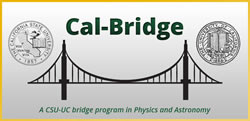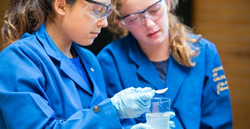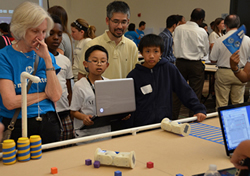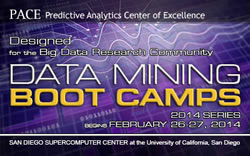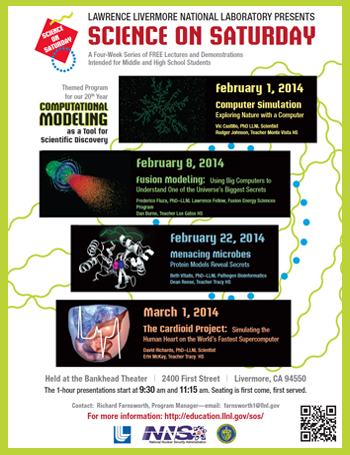HiPACC Education/Public Outreach Press Room Archive
The Education/Public Outreach Press Room highlights opportunities made available to K-12 or university students or the general public, to learn more about astronomy and computational or data science in all fields, offered by the UC campuses and DOE laboratories comprising the UC-HiPACC consortium. The wording of the short summaries on this page is based on wording in the individual releases or on the summaries on the press release page of the original source. Images are also from the original sources except as stated. Press releases below appear in reverse chronological order (most recent first); they can also be displayed by UC campus or DOE lab by clicking on the desired venue at the bottom of the left-hand column.This page is the archive. Click for current Education/Public Outreach press releases.
October 8, 2014 — Institute of Arts and Sciences offers LASER talk on Oct. 28
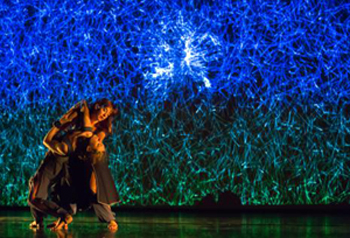
danceroom spectroscopy. Credit: David Glowacki
UCSC 10/8/2014—UC Santa Cruz’s Institute of the Arts and Sciences will present its first Leonardo Art/Science Evening Rendezvous (LASER) talk of the 2014–2015 academic year on Tuesday, October 28, at the Digital Arts Research Center. LASER is a national program of evening gatherings that bring artists, scientists, and scholars together for informal presentations and conversations. The goal of the LASER series is to feature compelling new developments in the arts and sciences, and to attract audiences that would not normally be found at the same gathering. Among the presentations will be one by David Glowacki, whose international reputation spans both computational nano-physics and interactive digital art. He is the creator of danceroom spectroscopy, an interactive science-meets-art installation that has introduced the beauty and complexity of the atomic world to thousands of people across the UK and Europe.
view UCSC Data Science Press Release
October 6, 2014 — UCSF at Dreamforce 2014: Revolutionary research powered by technology
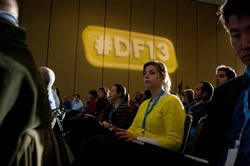
Attendees of Dreamforce 2013 listen to UCSF experts discuss how technology is changing health care.
UCSF 10/6/2014—A chip can solve cases of mysterious infectious diseases by applying innovative, rapid DNA sequencing technology. New genomic techniques are aiding in identifying genes that contribute to autism and other disorders. Video games designed with neuroscience can actually make you smarter. Prenatal exposure to industrial chemicals—found in food, water, consumer products, and the environment—can have intergenerational adverse health impacts. These are some of the revolutionary research discoveries and inventions that UC San Francisco scientists explore at noon on October 15, at Dreamforce 2014’s “Stepping Up to Lead” track.
view UCSF Data Science Press Release
September 25, 2014 — Opportunity knocks

Senior Ari Kaplan compared simulated models to the Large Hadron Collider's data. Credit: Spencer Bruttig
UCSB 9/25/2014—Six undergraduate physics majors participating in this year’s Worster Summer Research Fellowships at UC Santa Barbara were paid to conduct 10 weeks of research—ranging from astrophysics to biophysics to theoretical physics—under the direct supervision of graduate student mentors. Among them, senior Joey Wong examined how heavy metals behave in merging galaxies—information that may offer hints about how the Milky Way and Andromeda will merge in a few billion years. Junior Sylvia Madhow learned computer programming and data analysis techniques in Ben Mazin’s astrophysics lab, working on a new technique for analyzing the readout from microwave kinetic inductance detectors (MKIDs) used for astronomy in the near infrared, optical, ultraviolet and X-ray. Said astrophysicist Crystal Martin, a professor in UCSB’s Department of Physics: “One of the great opportunities that big research universities can offer is not only helping students learn all that is known about a topic, but also teaching young people to go out and create new knowledge and answer unsolved questions.”
 view UCSB Data Science Press Release
view UCSB Data Science Press Release
September 23, 2014 — LANS Board of Governors approves $3 million for education, economic development, charitable giving in Northern New Mexico
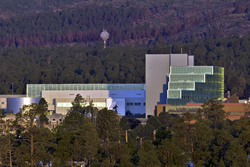
Los Alamos National Laboratory sits on top of a once-remote mesa in northern New Mexico with the Jemez mountains as a backdrop.
LANL 9/23/2014—The Board of Governors for Los Alamos National Security, LLC—the operating contractor for Los Alamos National Laboratory (LANL)—has approved $3 million in funding for the company’s plan to support education, economic development and charitable giving in Northern New Mexico. “This plan demonstrates our bond with the community and its people and businesses that support our national security mission,” said LANL Director Charlie McMillan. Funds approved by the LANS Board of Governors are administered through a Community Commitment Plan managed by LANL’s Community Programs Office. The LANS Community Commitment Plan has provided more than $28 million to the region since 2007. For 2015 the Plan will provide $1 million each for: education (including science, technology, engineering and math (STEM) programs); economic development (such as financial and technical assistance to start and grow regional businesses); and community giving initiatives and investments in the Northern New Mexico area.
view LANL Data Science Press Release
September 22, 2014 — Mixing it up on Science Hill

Rachel Doran, a 4th year graduate student, is investigating the immune responses of people infected with HIV who do not succumb to normal progression of disease to learn how their antibody responses make them resistant to AIDS. Graphic credit: David States
UCSC 9/22/2014—An innovative graduate program on UC Santa Cruz’s Science Hill is breaking down barriers between the biomedical sciences, encouraging interdisciplinary research, and enabling students from different departments and divisions to work closely together. Now in its sixth year, the graduate Program in Biomedical Sciences and Engineering (PBSE) is a collaborative graduate program that includes faculty from five departments spanning the Divisions of Physical and Biological Sciences and the Baskin School of Engineering. Originally, individual departments had their own graduate programs based on traditional disciplines, but research has evolved to a point where students now employ techniques and logic from multiple disciplines to attack interesting problems in biomedical research. So UCSC felt the need for a graduate program that reflects the collaborative and interdisciplinary nature of biomedical research at UCSC. In the past half-dozen years, PBSE has helped change the culture of Science Hill as well as the kind of student who is coming to UC Santa Cruz to study biomedical sciences. PBSE attracts students who are broad in their thinking, who think independently, who can make their own programs.
view UCSC Data Science Press Release
September 22, 2014 — Finding answers to basic questions about the Universe
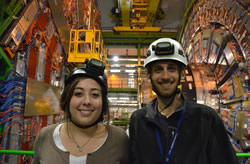
Elizabeth Kennedy and Jesse Heilman are two UC Riverside graduate students working at CERN, Switzerland. Credit: Sarah Charley/CERN
UCR 9/22/2014—Hundreds of graduate students from around the world work at CERN in Switzerland, home to the powerful particle accelerator the Large Hadron Collider (LHC). Among them are UC Riverside physics and astronomy graduate students Jesse Heilman and Elizabeth Kennedy, who are working on the Compact Muon Solenoid (CMS) experiment, a large particle-capturing detector. Hellman said: “CMS, of which UCR is a founding member, is one of two experiments at the LHC that has the capability to make measurements on things such as the Higgs boson. It is designed to sense a very broad range of phenomena and act as the most powerful microscope that our species has ever constructed.” Kennedy said: “Ambitious experiments require advancements in everything from computing power and data storage to superconducting magnets, so new and better technology comes from the demands of the field of experimental particle physics. Additionally, we train young scientists in not only particle physics, but general scientific research, engineering, and computer science.”
 view UCR Data Science Press Release
view UCR Data Science Press Release
September 9, 2014 — Computer scientists launch Kickstarter for video game that teaches kids how to code
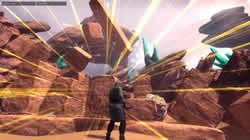
Screen shot from CodeSpells
UCSD 9/10/2014—Computer scientists at UC San Diego (UCSD) have successfully funded on Kickstarter a new and improved version of CodeSpells, a first-person player game they developed that teaches players how to code. The game’s previous iteration, developed by UCSD computer science Ph.D. students Sarah Esper and Stephen Foster, has been in use in dozens of schools throughout the world for more than a year. The researchers have been using the game as a platform to learn about the best ways to teach children how to code. In a paper “CodeSpells: Bridging Educational Language Features with Industry-Standard Languages,” the researchers demonstrate that after playing CodeSpells for either four hours over four weeks or 10 hours over seven days, children ages 8 to 12 were able to write code by hand in Java.
 view UCSD Data Science Press Release
view UCSD Data Science Press Release
September 4, 2014 — C-STEM Center high school math, robotics courses approved for UC admission
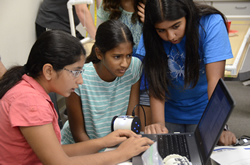
The C-STEM Center’s goal is to transform K-14 STEM education through the use of innovative computing and robotics technology to promote hands on learning that engages students in activities that relate STEM concepts to real life applications.
UCD 9/4/2014—Starting this fall, it will be easier for California high schools and intermediate schools to include UC-ready courses from the UC Davis Center for Integrated Computing and STEM Education (the C-STEM Center), in their curricula. That means that high schools can now readily adopt this research-based curriculum to help close the achievement gap and prepare students ready for career and college. Annual activities of the C-STEM program culminate in C-STEM Day held each May, when teams of schoolchildren gather to demonstrate their programming skills. The C-STEM Center will host the fourth annual Conference on Integrated Computing and STEM Education at UC Davis on Sunday, Nov. 9. The conference will bring together teachers, researchers, educators, policymakers and industrial partners to share their experiences, best practices, and ideas on the future direction of integrated computing and STEM education.
view UCD Data Science Press Release
September 3, 2014 — A path to the stars
UCI, 9/3/2014—Southern California students who excel in astronomy and physics but are traditionally underrepresented in those fields will soon get a big boost toward earning doctorates at University of California research campuses, thanks to a new mentoring and scholarship program. Cal-Bridge is a consortium of eight California State University schools, five UC campuses, and eight community colleges working to increase the number of underrepresented, often lower-income students who complete bachelor’s and Ph.D. degrees in astronomy, physics or closely related fields. Hispanics and women are among the targeted students. The National Science Foundation has awarded the group $600,000 for financial support and intensive joint mentoring of Cal-Bridge Scholars by community college, Cal State and UC faculty during the last two years of undergraduate education and first year of graduate school.
view UCI Data Science Press Release
August 27, 2014 — ‘HackTheHearst’ to expand public discovery of ancient treasures
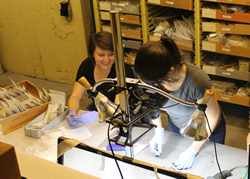
Students working to digitize a large set of Hearst Museum artifacts. Credit: Phoebe A. Hearst Museum of Anthropology
UCB 8/27/2014—A multiday hackathon beginning Sept. 10 aims to make the collection of ancient treasures at the Phoebe A. Hearst Museum of Anthropology at UC Berkeley more accessible to scholars and the public. The competition is open to anyone: Silicon Valley computer programmers, high school students, architects, designers, museum studies students, and more. HackTheHearst participants will work with a dataset of object-centric metadata for more than 700,000 catalog records dealing with everything from Mexican Saltillo serapes and ancient Egyptian artwork to Native American basketry. Some 196,920 objects in the museum’s collections have been digitally imaged so far. Museum officials are asking hackers to develop apps or user interfaces that facilitate interaction with digitized collection data by the public, especially students from kindergarten through college, researchers, Indian tribes and other heritage communities. Hackers also can attend a discussion about museums and their role in the humanities, digital tools, and resources—an area of research, teaching, and creation that is concerned with the intersection of computing and the humanities disciplines.
view UCB Data Science Press Release
August 8, 2014 — Berkeley Engineering launches Girls in Engineering summer camp
UCB 8/8/2014—Summer 2014, Berkeley Engineering hosted 60 fifth, sixth and seventh-graders for a new Girls in Engineering camp designed to inspire middle-schoolers to explore careers in STEM fields (science, technology, engineering, and math). Part of the college’s longstanding commitment to increasing the ranks of women in technology, the camps were offered free to students from five East Bay schools. Supported by grants from the National Science Foundation, General Electric, and the Baskin Foundation, two weeklong sessions included hands-on projects in nanotechnology, robotics, optics and more, as well as field trips to nearby Pixar Animation Studios and Lawrence Hall of Science.
view UCB Data Science Press Release
August 7, 2014 — UCLA undergrads are first to build an entire satellite on campus
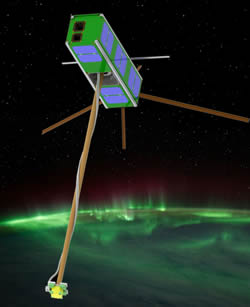
Once in orbit, ELFIN will study the phenomena that cause the dazzling auroras. Credit: ELFIN
UCLA, 8/7/2014—To conduct research on space weather, an enterprising group of UC Los Angeles undergraduates is manufacturing the first satellite built entirely on the UCLA campus. When launched in 2016 or 2017, the breadbox-sized Electron Loss and Fields Investigation (ELFIN) CubeSat will determine how solar wind particles and radiation behave in Earth’s environment, a topic of increasing concern because magnetic storms can wreak havoc on space infrastructure like GPS, communication and weather satellites, and even damage the electrical grid here on Earth. Uncertain whether the project would someday be fully funded, several dozen intrepid undergraduate students took on the project as their own, collectively putting in thousands of hours over three years as a labor of love, developing and testing the satellite’s subsystems. In 2013 the U.S. Air Force awarded the team a $110,000 grant to continue development and buy much-needed parts. In February 2014, the NASA’s CubeSat Initiative and the Low-Cost Access to Space program guaranteed them a launch spot. And in May, the team was awarded $1.2 million jointly from NASA and the National Science Foundation, ensuring enough funding to put the space-qualified hardware in orbit and to operate it for six months from the UCLA Mission Operations Center, to be located on campus.
view UCLA Data Science Press Release
August 6, 2014 — Teaching the Teachers
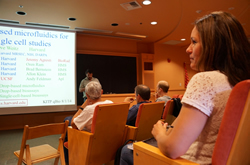
JulieAnn Villa, one of four teachers in residence at the Kavli Institute for Theoretical Physics, attends a lecture in the “The Evolution of Drug Resistance” program. Credit: Sonia Fernandez
UCSB 8/6/2014—For two weeks in July, four high school teachers in residence at UC Santa Barbara’s Kavli Institute for Theoretical Physics (KITP) spent their days attending lectures highlighting “The Evolution of Drug Resistance” or “Dynamics of Planetary Interiors,” and participating in informal discussions and labs with researchers, postdoctoral scholars and professors. The goal of the new teachers-in-residence program is to expose high school teachers to topics in modern physics. The program also included visiting the nearby Dos Pueblos Engineering Academy (DPEA). All four teachers saw ways to apply parts of what they learned in their classrooms, and felt seeing actual research provided valuable insight into the application of science and mathematics. “I thought it was really important for me to be exposed to where all this knowledge is eventually used, to know that there is a use, and that I’m not just teaching it because it’s in the curriculum,” said one teacher. “Even if students aren’t going to use it, at least I can tell them how and where people do, and perhaps create a bit of appreciation for it.”
view UCSB Data Science Press Release
July 14, 2014 — Labs, industry join forces to train cyber security specialists for nation’s critical cyber infrastructure
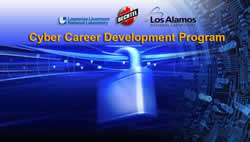
LLNL 7/14/2014—Lawrence Livermore National Laboratory (LLNL) is joining Los Alamos National Laboratory (LANL) and Bechtel BNI to train a new class of cyber defense professionals to protect the nation’s critical digital infrastructure. About 80 percent of the nation’s critical digital infrastructure and assets are owned and operated by private industry. The Bechtel-Lawrence Livermore-Los Alamos Cyber Career Development Program is designed to allow the national labs to recruit and rapidly develop cyber security specialists who can guide research at their respective institutions and create solutions that meet the cyber defense needs of private industry. The program will provide recruits with experience in the labs’ national defense research and development culture plus hands-on experience in Bechtel’s global cyber operations. The goal is to produce cyber defenders with first-hand knowledge of the security challenges faced by private industry, and the tools to address those problems.”
view LLNL Data Science Press Release
June 27, 2014 — Making computational science super cool!
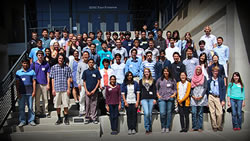
SDSC starts 2014 summer internship program for high school students
SDSC 6/27/2014—The San Diego Supercomputer Center (SDSC) at UC San Diego held its fifth annual Research Experience for High School Students (REHS) summer program, where students join multidisciplinary research teams and staffers at the Center to gain experience across a wide array of computational research. Expanded to eight weeks, the REHS program ran through August 15. Internships of 15 to 25 hours a week are coordinated with SDSC Principal Investigators and other staffers serving as mentors in the program. Interns work with SDSC researchers in many fields, including developing molecular dynamics software, advancing drug designs for Parkinson’s Disease, understanding and managing large data sets and scientific workflows, working on projects related to predictive analytics, developing reliable network and information technology infrastructures, and learning how to effectively communicate and publicize research projects and their results.
view SDSC Data Science Press Release
June 26, 2014 — Ten local businesses to receive Venture Acceleration Fund awards

Elizabeth and Roger Inman of Purple Adobe Lavender Farm in Abiquiu, N.M.
LANL 6/26/2014—Los Alamos National Security, LLC (LANS) and its partners recently awarded more than $400,000 to 10 local businesses to help them grow and develop in Northern New Mexico. The grant awards are administered by the Regional Development Corporation’s Los Alamos Connect program in coordination with Los Alamos National Laboratory. This Venture Acceleration Fund was originally created to commercialize technologies developed at the Lab but now includes all types of businesses in every stage of development. Awards were given to five companies in Santa Fe, two each from Rio Arriba and Taos counties and one from Albuquerque. Related to computational science, one 2014 Venture Acceleration Fund recipient was Flow Science in Santa Fe for computational fluid dynamics modeling software packages.
view LANL Data Science Press Release
June 26, 2014 — UCSC graduate student is a new kind of storyteller

Aaron A. Reed
UCSC 6/26/14—Aaron A. Reed is a storyteller for whom writing involves both words and computer code. Currently working toward his Ph.D. in computer science at UC Santa Cruz, Reed is already a prominent author in the world of interactive fiction, merging literary storytelling techniques with the technology of computer games. Reed came to UCSC in 2009 for the Digital Arts and New Media program, earning his M.F.A. in 2011. His initial exploration of new ways of storytelling through games had two goals: to involve the reader in the outcome of the story and to develop an interactive story in a way that didn’t require a Ph.D. in computer science. Eventually, however, he decided that advanced work in computer science would give him the best tools to address some of the storytelling challenges he was facing as a writer. So he moved on to UCSC’s computer science graduate program, working with faculty in the Expressive Intelligence Studio at the Center for Games and Playable Media. Reed’s games experiment with different approaches to interactive storytelling, and the experiments are paying off. One recent project, 18 Cadence, has earned accolades from both the literary community and experimental game developers.
view UCSC Data Science Press Release
June 20, 2014 — The Henry Samueli School of Engineering at UCI receives $9.5 million gift
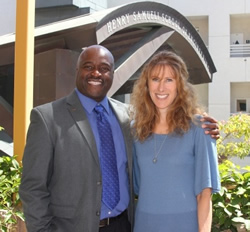
Stacey Nicholas, whose Opus Foundation facilitated a $9.5 million donation to the Samueli School of Engineering, said she greatly admires and supports Dean Gregory Washington’s commitment to outreach, diversity and innovation in STEM education. “I am thrilled to be able to make a difference,” she said. Credit: Henry Samueli School of Engineering
UCI 6/20/14—Stacey Nicholas’ Opus Foundation has made a $9.5 million gift to The Henry Samueli School of Engineering at UC Irvine. The donation will establish a $2 million endowed deanship; fund student scholarships and graduate fellowships; and support school programs that focus on science, technology, engineering and mathematics (STEM) outreach. It will also facilitate an ongoing partnership with St. Margaret’s Episcopal School in San Juan Capistrano. $5 million will support the Academic Innovation & Research in Engineering (AIRE) program, which conducts K-12 and community college outreach and promotes interest in STEM subjects through project-based learning. A $2 million endowment will be established to support the Samueli School directed toward K-12 and undergraduate engineering education initiatives. An endowment of $1 million will create need-based scholarships for underrepresented students in engineering. A $1 million endowment will fund graduate fellowships for underrepresented students. And $500,000 will be used to create a study area within the school.
view UCI Data Science Press Release
June 19, 2014 — RadWatch project brings near real-time radiation data to the public
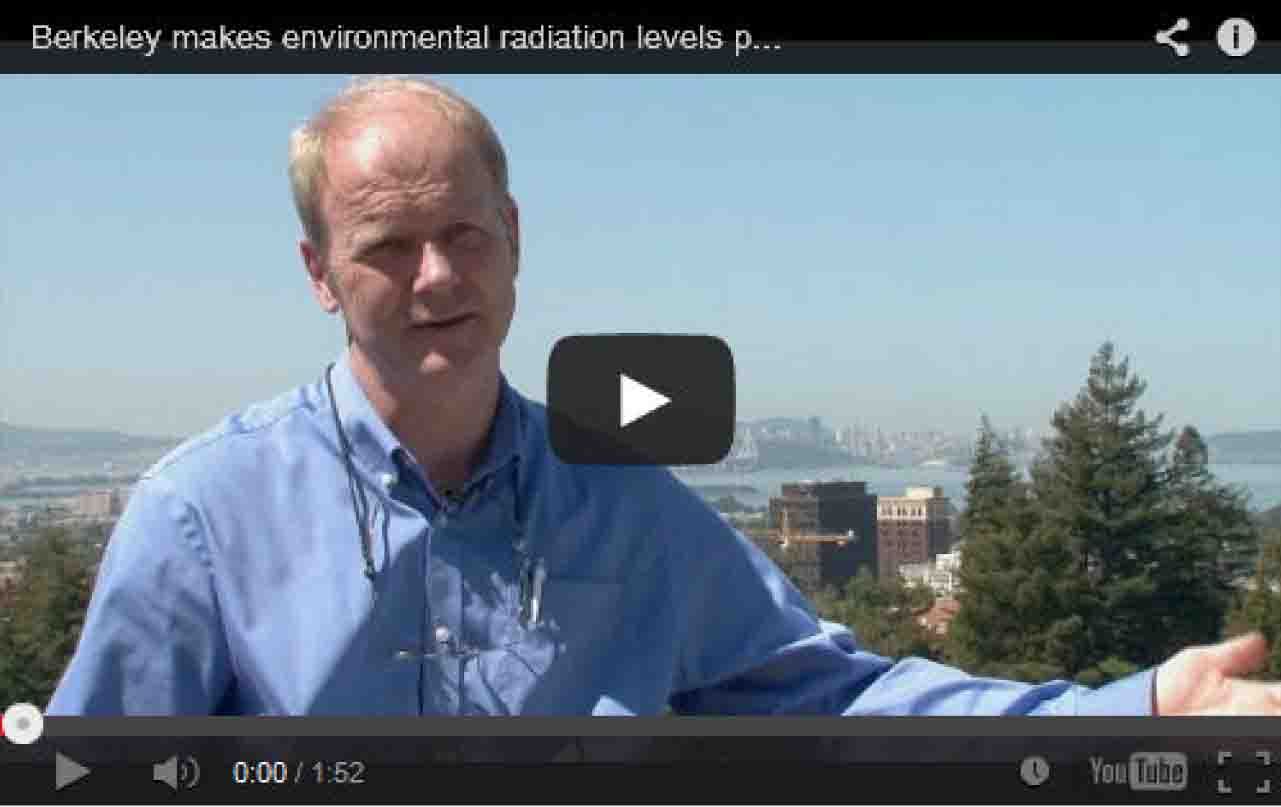
Video by Roxanne Makasdjian and Phil Ebiner, UC Berkeley
UCB 6/19/14—Radioactivity is all around us, and UC Berkeley researchers want the public to know it. A team of scientists led by Kai Vetter, UC Berkeley professor-in-residence of nuclear engineering, seeks to provide online access to a wealth of information on environmental radiation levels to help demystify an often misunderstood subject. Called RadWatch, the project presents results of radiation testing from a wide range of samples, such as California fish, soil, and cows’ milk. The latest development is the installation of a new automated air-sampling system, posting a constant stream of data from highly sensitive air monitors online for the public to see. RadWatch currently focuses on cesium-134 and cesium-137, the primary radioisotopes associated with Japan’s devastated Fukushima nuclear plant, to distinguish releases from the facility’s March 2011 meltdown and fallout from nuclear weapons testing from the 1940s and ’50s—something simple Geiger counters cannot do. “The RadWatch project is a great example of how UC Berkeley combines research with student training and public education,” said Vetter, who is also head of the Applied Nuclear Physics Program at Lawrence Berkeley National Laboratory.
view UCB Data Science Press Release
May 27, 2014 — Schools robotics day at UC Davis and in Orange County
UCD 5/27/14 — C-STEM Day, the annual celebration of school students’ skills in programming, robotics and math on Saturday, May 31, at UC Davis and at UC Irvine involved over 100 student robotics teams. C-STEM Day is the culminating experience for middle- and high-school students who have been working for the past year with science, technology, engineering and math curricula developed by the UC Davis Center for Integrated Computing and STEM Education, with support from the National Science Foundation. The students used Barobo Linkbots—small reconfigurable robots—to learn programming, algebra, and math in a fun and accessible way.
view UCD Data Science Press Release
May 12, 2014 — Innovate to Grow Competition Highlights student creativity
UCM 5/12/14 — From disposable drones mapping wildfire perimeters to increasing the number of young students interested in science, technology, engineering and math studies, this year’s engineering capstone and Innovate to Grow teams showcase real, impactful work by engineering undergraduates. The annual Innovate to Grow competition and expo across the UC Merced campus on Friday, May 16, offered demonstrations of each team’s work plus blue-ribbon panels and cash prizes. Innovate to Grow, free and open to the public, is an annual celebration of UCM students’ creativity, and a launching pad for enterprises based on some of their most promising—and sometimes patentable— inventions and solutions to engineering challenges faced by partnering regional agencies and businesses.
view UCM Data Science Press Release
May 12, 2014 — Undergraduate Research Week celebrates students’ diverse accomplishments
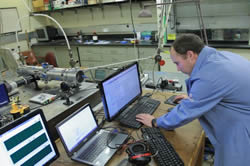
Brett Lopez, an aerospace engineering student who is presenting his project during UCLA's Undergraduate Research Week, examines how different alternative fuels react to sound waves. Credit: UCLA
UCLA 5/12/14 — Brett Lopez, a UCLA aerospace engineering student, conducts experiments on how different alternative fuels — such as methanol and ethanol — react to sound waves. The senior is just one of approximately 600 students who presented their research prowess and talents during Undergraduate Research Week May 12–16 at UCLA’s Powell Library. Open to all UCLA undergraduates, Undergraduate Research Week provides opportunities for students to present their research in the sciences, humanities, arts, and social sciences to the campus and broader community. UCLA undergraduates “have the opportunity to conduct the kind of high-level and meaningful research that often isn’t available to students until graduate school,” said Patricia Turner, dean and vice provost of undergraduate education in the UCLA College of Letters and Science.
view UCLA Data Science Press Release
May 7, 2014 — Cosmologist Tom Abel explores the early universe in public lecture May 27
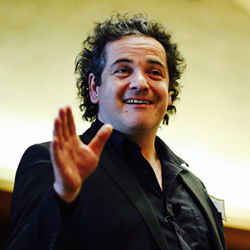
Tom Abel
UCSC 5/7/14 — Cosmologist Tom Abel discussed the early history of the universe in the inaugural public Mandel Lecture called “Cosmic Dawn: The First Billion Years of our Universe.” Abel is a computational cosmologist who explores cosmic history using supercomputer calculations. An associate professor of physics at Stanford University and the Stanford Linear Accelerator Center, he directs the Kavli Institute for Particle Astrophysics and Cosmology at Stanford. In his talk, Abel took the audience on a fascinating journey through the early universe using the latest computer animations of early star formation, supernova explosions, and the build-up of the first galaxies. Computer simulations of these events combine the physics of dark matter and the ordinary matter of atoms and molecules, the expansion of the universe, chemistry, and gas dynamics to deliver remarkable insights into the early history of the cosmos. Abel’s long-term goal is “to build a galaxy, one star at a time” via computer modeling.
view UCSC Data Science Press Release
May 6, 2014 — Teen Mentored by UC San Diego professors wins $250,000 in science prizes

Eric Chen and UC San Diego Professor Rommie Amaro. Credit: Erik Jepsen UC San Diego Publications
SDSC 5/6/14 — A 17-year-old senior at Canyon Crest Academy in San Diego’s North County recently won not one, but three major science competitions after being mentored by two University of California, San Diego professors in a project that combined supercomputer modeling with experimental research to speed up the discovery of influenza virus inhibitors. In all, Eric Chen was awarded $250,000 in prize money within the past 12 months by winning the trifecta of science competitions: the 2014 Intel Science Talent Search; the 2013 Siemens Competition in Math, Science & Technology; and the grand prize in the international 2013 Google Science Fair. Chen’s computations—using SDSC’s Gordon supercomputer—ran molecular dynamics computations as part of the BioChemCoRe outreach program organized by Rommie Amaro, an associate professor of chemistry and biochemistry at UC San Diego.
view SDSC Data Science Press Release
May 2, 2014 — The Exploratorium and UC Davis announce science and sustainability partnership
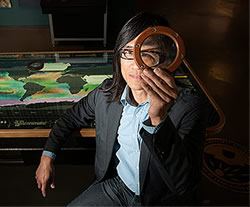
Kwan Liu Ma, director of the UC Davis Center for Visualization, co-developed an interactive exhibit uses data visualizations and touch interactions to allow users to explore plankton populations around the world. Credit: Gregory Urquiaga/UC Davis photo
UCD 5/2/14 — UC Davis, and the Exploratorium in San Francisco have formally partnered to incorporate the latest scientific innovations into the museum’s exhibits and programs. The partnership will encompass a broad cross section of research topics, such as environmental science, sustainable energy, data visualization, coastal and marine sciences, and sustainable agriculture and food science. This strategic five-year partnership with UC Davis is “designed to be an open and generative partnership among our scientific and educational staffs,” said Dennis Bartels, Exploratorium executive director. “It’s already resulted in exhibits on our floor like the highly interactive world plankton table, which broke new ground in the hot area of scientific data visualizations.”
view UCD Data Science Press Release
April 22, 2014 — La Cueva High School team takes top award in 24th New Mexico Supercomputing Challenge
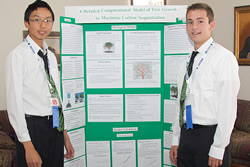
Albert Zuo, left, and Eli Echt-Wilson of Albuquerque La Cueva High School with their poster. They won the top award at the 24th New Mexico Supercomputing Challenge at Los Alamos National Laboratory.
LANL 4/22/14 — Eli Echt-Wilson and Albert Zuo from La Cueva High in Albuquerque won the top award at the 24th New Mexico Supercomputing Challenge at Los Alamos National Laboratory. Their project, called Modeling Tree Growth and Resource Use with Applications, proposed a unique model that simulates deciduous tree growth at the level of individual branches and leaves based on underlying biological processes. “The goal of the yearlong event is to teach student teams how to use powerful computers to analyze, model, and solve real-world problems,” said David Kratzer of Los Alamos’ High Performance Computer Systems group, and executive director of the Supercomputing Challenge. “Participating students improve their understanding of technology by developing skills in scientific inquiry, modeling, computing, communications, and teamwork.”
view LANL Data Science Press Release
April 16, 2014 — UCSC grad students to showcase digital art with social impact
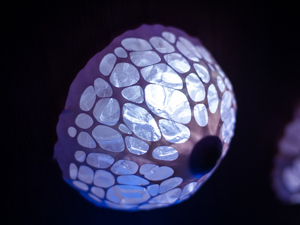
Gene A. Felice II worked with OpenLab and DANM’s Mechatronics Research Group to develop his Oceanic Scales project.
UCSC 4/16/14 - Eleven graduate students from the Digital Arts and New Media M.F.A. Program (DANM) at UC Santa Cruz will conclude two years of artistic study with “Undercurrents”—an exhibition running on campus April 26 through May 4 at the Digital Arts Research Center. This year’s students have particular concerns about the environment and sustainability. Curated by Shelby Graham, the featured works range from interactive ecological installations to site specific projections, all employing advanced technologies to explore the edges of contemporary new media art.
view UCSC Data Science Press Release
April 16, 2014 — Students descend on Los Alamos National Laboratory April 21-22 for Supercomputing Challenge Expo and awards ceremony
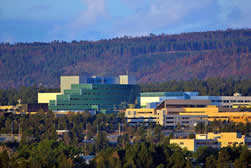
Los Alamos National Laboratory sits on top of a once-remote mesa in northern New Mexico with the Jemez mountains as a backdrop to research and innovation covering multi-disciplines from bioscience, sustainable energy sources, to plasma physics and new materials.
LANL 4/16/14—Some 70 teams totaling more than 250 New Mexico K–12 students and their teachers will be at Los Alamos National Laboratory April 21–22 for the 24th annual New Mexico Supercomputing Challenge expo and awards ceremony. “The goal of the year-long competition is to increase knowledge of science and computing, expose students and teachers to computers and applied mathematics, and instill enthusiasm for science in middle- and high-school students, their families and communities,” said David Kratzer of the Laboratory’s High Performance Computer Systems group and LANL’s coordinator of the Supercomputing Challenge.
view LANL Data Science Press Release
April 15, 2014 — What does past global warming teach us?
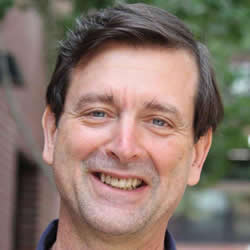
Scott L. Wing is Curator of Fossil Plants in the Department of Paleobiology at the National Museum of Natural History. (Credit: National Museum of Natural History)
UCR 4/15/14 — Human emissions of greenhouse gases are altering environments and climate globally, and will continue to do so for many thousands of years into the future. The past event that best mirrors present-day warming occurred 56 million years ago and is called the Paleocene-Eocene Thermal Maximum (PETM). The PETM began with a geologically sudden release of an amount of carbon roughly similar to that in modern fossil fuel reserves, causing global warming of 4-8 degrees Celsius. Climatologists estimate the rate and magnitude of future climate change using general circulation models (GCMs). Biologist Scott L. Wing uses fossil plants to reconstruct past climates and local environments, which can reveal GCM strengths and weaknesses. In a free public lecture on Wednesday, April 23, at UC Riverside, Wing will discuss a large team of paleobotanists adding data on fossil plant assemblages to a Web-accessible database maintained at the National Center for Ecological Analysis and Synthesis—a database that will allow scientists to better quantify changes in the diversity and composition of terrestrial floras across the whole history of life on land.
view UCR Data Science Press Release
April 4, 2014 — Twinkle, twinkle little star

A massive, hot supergiant, Kappa Cassiopeiae is surrounded by a streaky red glow of material in its path called bow shocks, often seen in front of the fastest, most massive stars in the galaxy. (Credit: NASA/JPL-Caltech)
UCSB 4/4/14 — “Humans have always tried to understand what the lights in the sky are as well as their meaning and function,” Matteo Cantiello, an astrophysicist at UC Santa Barbara’s Kavli Institute for Theoretical Physics (KITP), told the standing-room-only crowd at SOhO restaurant in Santa Barbara Wednesday night. They had gathered for the inaugural Café KITP, a series whose motto is “Eat, THINK, and be merry!” to hear Cantiello’s talk on “Music of the Spheres: The Secret Songs of the Stars.” Café KITP came to be as a collaboration between the KITP and its current journalist-in-residence, Ivan Amato, a science and technology writer, editor and communicator based in Silver Spring, Maryland. “One of the drivers for me is that science is part of culture not apart from it,” said Amato. “I think the greatest gift that science has to offer is really the invitation to experience awe as science reveals how nature works.”
view UCSB Data Science Press Release
March 31, 2014 — Music and stargazing draw summer visitors to Lick Observatory
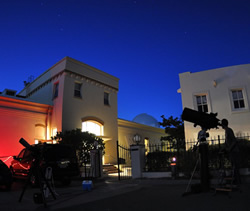
Stargazers gather at Lick Observatory for Music of the Spheres concerts and other summer programs. (Photo by Michael Bolte)
UCSC 3/31/14 — For more than three decades, the summer programs at UC's Lick Observatory have drawn music lovers and astronomy buffs to the top of Mt. Hamilton for concerts, lectures, and opportunities to view the night sky through the observatory’s history-making telescopes. This summer will be the 34th season of these popular evening programs. Music of the Spheres is a benefit summer concert series whose proceeds support Lick Observatory. Each of the four Music of the Spheres evenings combines a performance by world-acclaimed musicians and a lecture by a renowned astronomy researcher. Afterward, audience members take turns looking through the historic telescopes: the 36-inch Great Lick Refractor and the 40-inch Nickel Reflector. Volunteers also share their own telescopes and expertise with interested members of the audience.
view UCSC Data Science Press Release
March 26, 2014 — UCSC students will code for Santa Cruz in April 5-6 ‘hackathon’

Launch Hack 2013 in San Francisco. (Photo by Mark Adams)
UCSC 3/26/14 — The first UC Santa Cruz “hackathon” will take place on the weekend of April 5 and 6 at the Oakes Learning Center, bringing together student developers, designers, and entrepreneurs to produce mobile apps and web programs in a 32-hour competition. Organized by the UCSC Center for Entrepreneurship, HACK UCSC 2014 is supported by the Santa Cruz tech community, which has donated $10,000 in prize money to be shared by the top four teams. The theme of the event is “Santa Cruz.” The apps and programs developed by student teams will be scored on their relevance to the Santa Cruz community, technical merit, and novelty. Industry veterans from the tech community have volunteered to serve as mentors for the student teams.
view UCSC Data Science Press Release
March 25, 2014 — Physics and astronomy to host annual open house on April 12
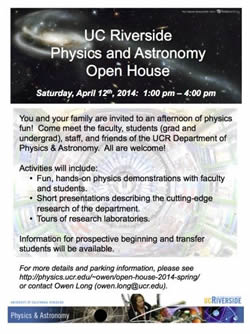
Flyer for the 2014 physics and astronomy open house
UCR 3/25/14 — The Department of Physics and Astronomy at UC Riverside will host its annual open house on April 12, 2014 from 1–4:30 p.m., allowing visitors to have one-on-one interactions with faculty and students and get to know all about the cutting-edge research the department conducts. Fun, hands-on demonstrations of electricity, magnetism and sound/music—which have proven popular with children—will take place in the courtyard and inside the Physics Building. Presentations that showcase UCR research will be held in the lobby and classrooms of the Physics Building. The 20-minute presentations on astrophysics, cosmology and condensed matter physics will start at 2 p.m., take place in Room 3041 (the Reading Room), and be given twice; the talk on high energy physics will be ongoing in the lobby. Admission and parking are free.
view UCR Data Science Press Release
February 4, 2014 — SDSC’s 2014 Series of Data Mining ‘Boot Camps’ Begins February 26–27
SDSC 2/4/14 — The San Diego Supercomputer Center (SDSC) at UC San Diego is kicking off its 2014 series of “Data Mining Boot Camps” aimed at helping business professionals and academic research scientists gain a clear understanding of how to rapidly translate the burgeoning amounts of data and learn how to design, build, verify and evaluate predictive models.
view SDSC Data Science Press Release
January 23, 2014 — Data science master’s degree kicks off to fill growing need across industries

MIDS students participate in live, face-to-face classes with fellow students and professors online.
UCB 1/23/14 — The UC Berkeley School of Information has officially started the first semester of its new Master of Information and Data Science (MIDS) program. Delivered online, the MIDS program provides a multi-disciplinary curriculum that prepares students in any career to solve real-world problems across their organizations using complex and unstructured data.
view UCB Data Science Press Release
January 15, 2014 — LLNL's Saturday lectures explore computational modeling
LLNL 1/15/1 — Lawrence Livermore National Laboratory’s popular lecture series, “Science on Saturday,” returns Feb. 1 and runs through March 1. This year marks the 20th anniversary of the program. The series will offer four lectures with a theme of computational modeling. Topics include exploring nature via computer simulation; fusion modeling; menacing microbes; and simulating the human heart on the world's fastest supercomputer. The lectures are free and will be held in the Bankhead Theater, located at 2400 First St. in Livermore. Two presentations are offered at 9:30 and 11:15 a.m. Each lecture highlights cutting-edge Lawrence Livermore National Laboratory (LLNL) science presented by leading Lab researchers who are joined by master high school science teachers.
view LLNL Data Science Press Release








